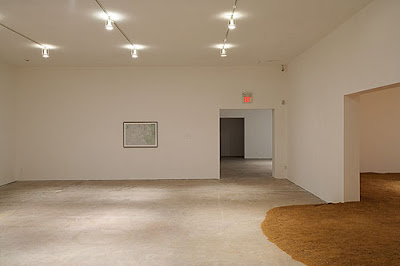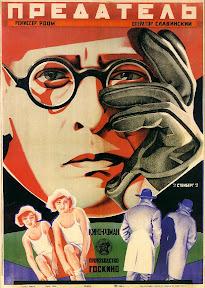Tuesday, September 25, 2007
High Mayhem, Saturday ~ Loud Objects
It went a bit like this: two gentlemen set up a standard transparency projector -- the one they used to use in science class -- and secured to it a transparent plastic panel. With only a single input, the gentlemen proceeded to practice a creator-surgery (the almighty god sort) on the panel and the input, which was hooked up to large speakers in front of the projection. Creator-surgery, the word I have (regretfully?) chosen to describe their work, was a sort of construction of sound by soldering wires to the input on one end and circuits laid onto the panel on the other; as they soldered different combinations, different frequencies of sound were manipulated through the wires and the circuits, ending up at the input and eventually experienced (sensorially) by the audience.
(During one hilarious moment that I won't recount, except here, in a super brief aside, a bug flew into some superglue, used to secure the circuits to panel, but miraculously escaped and became part of the performance. I believe I heard one man shout out, minutes after the now-averted disaster, "where's the bug?" Please understand that the similarity between circuits, which are commonly 6-pronged, and bugs is not lost to me: I'm calling for papers discussing it.)
As the show went on, the sound became more and more complex; a beat emerged, oscillating tweaks and twangs intertwined in movement variations, and the audiences' pulses raced in excitement. We (us, that audience - a necessary component, as pointed out by my dear friend Jesse (now undergoing a sort of reversal creator-surgery at the moment: his wisdom teeth are being pulled)) watched from our bleacher seats as we witnessed the construction of both the input/instrument and the sound; The sheer unpretentiousness of the construction and subsequent manipulation made the whole thing, shall we say, enlightening.
A really phenomenal performance.
Saturday, September 15, 2007
Hans Schabus, SITE Santa Fe, and installation loneliness

SITE Santa Fe, the contemporary art space on Santa Fe's Railyard District, commissioned an Austrian artist named Hans Schabus to take over their entire building with his meditations on the desert. From the essay accompanying the exhibition:
In Deserted Conquest (2007) -- an installation commissioned by SITE Santa Fe and the artist's first solo museum exhibition in the United States -- Schabus stages a series of confrontations (permanence vs. mobility; the grid vs. spiral form; artificial vs. natural; among others) within the New Mexico landscape that questions our beliefs about the desert and the American West. The objects in this exhibition -- a deconstructed mobile home, two videos, collages, over 100 tons of dirt, and an assortment of "found" items -- not only embody the oppositions that Schabus sets up, but also speak abstractly to notions of history, mythology, and alienation.
-- From the Exhibition Essay, which fails to mention an author's name.

As a whole, I enjoyed the space very much. Schabus makes huge installations out of mobile homes and the walls of old buildings, using their weathered and dilapidated aesthetics in contrast to the whiteness of the gallery space. He accents this with Cabin Fever, an interesting wagon wheel chandelier holding some two dozen candles, continuously lit and allowed to drip onto the floor over time.

In addition to these installations, Schabus takes some video footage from Yeso, NM, juxtaposing the loud, oncoming train with the dead quiet of the now ghost town. It was a stunning video that really resonated the emptiness of Yeso's spaces and the power and beauty of an oncoming train. The piece is called East, West, South, North
The title installation, Deserted Conquest is something like 10 tons of dirt packed down into a room that has its title emblazoned on the wall in steel. I imagine the space changes over time as visitors explore the empty room that is literally just full of desert dirt.



But what was most interesting, however unintended, was the fact that I was almost alone in this room. That is to say, I was actually the only patron in the entire gallery when I viewed it, but I was not the only human being. As I walked into the building, I was greeted at the desk and immediately headed into the exhibition (it was Friday, which means that there is no admission fee). I was tailed by a young woman, probably in her early twenties, who was carrying a walkie-talkie and was dressed in the casual, dark toned uniform of a SITE employee. She told me to watch my head on a specific, slightly hidden piece. This was our last direct interaction; after that, she casually milled about in whatever vicinity I was in the museum.
Now, I understand this is her job, but I felt sorry for her because she was obviously uncomfortable walking around with me but without interacting with me, basically "keeping watch" over something that hardly needed watching-over. I ended up feeling strange because I was wandering in Schabus' purposeful emptiness, an expanse that, like our romantic notions of the desert journey, seems best suited for solo exploration. Happening upon the space at the right moment allowed me such a solitary experience that was constantly disrupted by the woman guarding me throughout my viewing of Schabus' work.
Ultimately, I came to associate her presence with that of a ghost. She would not follow directly behind me, but rather wander between the rooms quickly enough to not seem like I was under constant surveillance. I instead felt like I was always vaguely being followed by something that, upon turning around, was just disappearing behind a corner.
In the end, this added to the experience Schabus sets up in his recreation of the solitude and expanse of the desert, as the ghost town of Yeso came to embody the dirt covered floor, leaving only a wispy trace of life that is always just behind you but outside of reach, outside of language, and experiencing something wholly different than you are.
Monday, September 10, 2007
The Luxury of Time
(An aside: I remember what Deleuze said about the American journey vs. the French -- it's an interesting take on something (today) we wouldn't necessarily assume. The American journey is the journey into the smooth, an escape from striation.)
In preparation for the seven hour journey, I uploaded some podcasts into my ipod. Though I usually listen to music, this trip I found that for such long treks listening to conversations and lectures open up a different sort of intellectual stimulation that were more metaphysically enlightening. I had previously found some In Our Time podcasts and downloaded a couple. Now, I can't seem to download individual podcasts or archived ones. Strange.
An interesting thing about aural media in combination with driving is that there is an intermixing of disembodied philosophical speculation and the movement of one's body in space. The landscape coming down from the mountains of Colorado into New Mexico presents a vast scene that is simultaneously endless and yet free of a daunting blandness; trees and vistas poke out of the fluid, lapping waves of the ground. Such a beautiful expanse paired with the spark of philosophical banter made me realize the luxury of the moment. These moments are few due to the constant distractive jarring of our normal lives in the milieu.
It is quite an interesting place to be -- contextualized in nature around oneself yet encapsulated in a vehicle that moves quickly along the ground. A sort of hovering in the Umwelt. Though surrounded by very technology that facilitates this experience, one feels in tune with the phenomenological thread at the edge of consciousness, and perhaps reveals that plane in which the two merge and emerge into one another.
As we align ourselves into the openness, we streamline the intellectual rhizome as is bursts forth from our bodies in space: like releasing a ghosted line of fog as we go along, we insist on the creation of form through the mesh of spirit.
Tuesday, September 04, 2007
Blackle - Google and Color Inversion
(.com)
because inverted colors are more sustainable. and, occasionally, more interesting. the (.com) is the actual site.
Another trick that serves the same purpose but operates system-wide (mac os x wide) is:
that inverts the colors on mac os x. It isn't an extremely advanced trick, but if you're running low on battery life and/or care about saving whatever energy you can, try it out. just don't try it with blackle on, because then you're inverting the already inverted colors, which means that you're totally counteracting whatever small change you were enacting.

